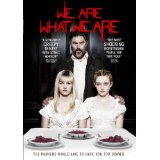Within the first few minutes of We Are What We Are, the Parker family suffers an immense loss. The death doesn’t exactly come as a shock because the film opens with a series of arresting and foreboding images doused by a torrential rain that fails to wash away the family’s worries (or incriminating evidence). This atmospheric, thoroughly creepy horror movie winds up going to a number of grisly places, but, in a lot of ways, it’s really just the story of how the reclusive clan deals with that loss.
We Are What We Are is technically a remake of the 2010 Mexican film Somos Lo Que Hay. I say “technically” because the new film — directed stylishly and confidently by Jim Mickle (Stake Land) — is more of a companion piece to the original. The two films share a basic premise about families who experience a sudden death and struggle to carry on their gruesome traditions, but Mickle and writer/actor/frequent collaborator Nick Damici have transplanted the action from inner-city Mexico to upstate New York.
With Parker family patriarch Frank (Bill Gage) seemingly paralyzed with grief, it’s up to his daughters to pick up the slack. Iris (Ambyr Childers) is the oldest and has the responsibility of being the new head of household thrust upon her. Rose (Julia Garner) is slightly more mischievous than Iris but remains fiercely protective of her family, which also includes youngest brother Rory (Jack Gore, an excellent name for a horror movie actor). When their unhinged dad isn’t looking, both Iris and Rose wonder aloud if they really need to continue the Parker family’s unsavory family ritual, especially since the town doctor (Michael Parks) and the young deputy who has eyes for Iris (Wyatt Russell) are sniffing around their property asking about missing girls.
I don’t want to say too much more. I realize there’s a decent chance you can look at the film’s cover art or come across a more spoiler-y synopsis and easily figure out what’s going on here. But I’d discourage you from actively seeking info on the film’s plot because the less you know going in, the better. Mickle and Damici — with a nice assist from cinematographer Ryan Samul — take great care in establishing their unsettling mood. In other words, all those close-ups of various types of flesh aren’t there by accident.
The film also takes an intriguing path by foregoing a traditional protagonist and focusing on the ritualistic family. (The closest doppelganger I can think of is Frailty, Bill Paxton’s underrated directorial effort.) Most of these types of stories are told from the perspective of the victim or the law enforcement personnel trying to save that victim, which gives the audience an obvious hero/heroine to root for. We Are What We Are doesn’t let us off quite so easy, but it also stops well short of demonizing the Parkers. The family unequivocally performs monstrous acts, but you don’t have to work too hard to understand the characters’ motives. Even scary Frank mostly comes off as a guy thoroughly ill-equipped to run a home, so he forces his family to default back to what they’ve always done because he doesn’t know any better. I mean, it’s tradition!
Gage makes for a convincingly demented presence, but the film is actually carried by the two impressive young actresses who play Frank’s daughters. They each mix in resignation and an innate, teenage desire to explore the outside world with an instinct to protect their tiny corner of the universe at any cost. (Witness the shifty, conflicted looks on their faces whenever they interact with anyone outside the family.) Parks is sympathetic and unspectacular as the only guy in town who dares to think the unthinkable about the Parkers, and Russell makes for a likable enough romantic lead. Kelly McGillis (Top Gun, Witness) also turns up in a small-ish, mostly thankless role as a caretaker.
I do, however, wish Mickle and Damici had found a less clichéd motivation for the Parkers’ actions than simply making them religious nuts. (The unofficial family mantra, established centuries earlier: “It is with love that I do this. God’s will be done.”) The flashbacks themselves feel a little half-baked and underdeveloped compared with the extravagant care given to the present-day scenes. There are also a couple of sequences when the filmmakers overplay their hand from a stylistic perspective by unnecessarily cross-cutting between various characters and time periods.
Fortunately, the film bounces back with a spectacularly grotesque and tense climax set at the Parker family dinner table. (The savagery on display is basically an extreme version of the similarly poisonous sequence in August: Osage County.) Mickle and Damici’s brand of gothic horror makes me excited to see their next collaboration, a thriller called Cold in July starring Michael C. Hall. We Are What We Are doesn’t offer your typical brand of slasher kicks; the violence comes in quick bursts, and the chills in this film get in your bones and unsettle you from within. This is a well-done thriller that I’m happy to recommend…provided you (like the characters in the film) have a strong stomach.



